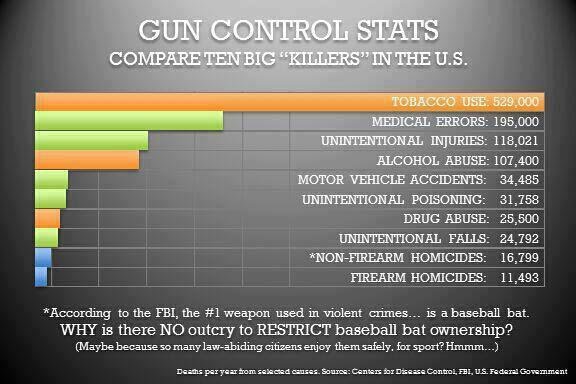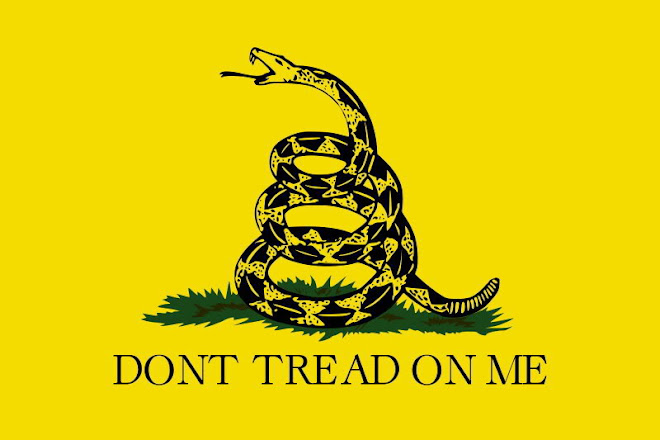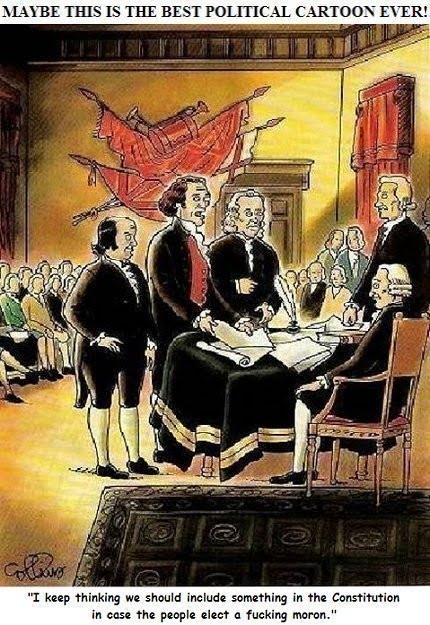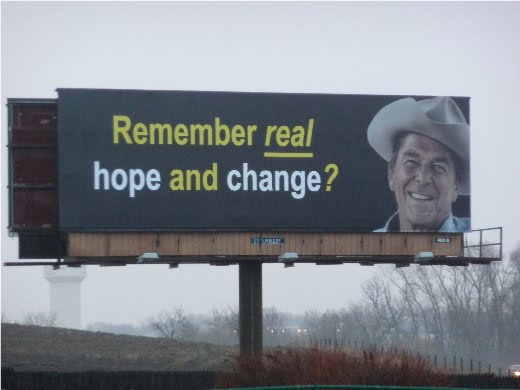Now this is from Bloomberg, so consider the source. My friend Al G. from MI. emailed today and said, if you hear that MI is no longer in play, and no more ads will be run, that is not true. So I'll believe Al before anything from Bloomberg. Regardless, this is not great news if indeed, Obama doesn't have to spend to defend PA & MI. We need those two states to be in play to take the pressure off the truer "swing states."
Laura Ingraham said if the Reublicans can't beat this terrible President, they should blow up the Party and start from scratch. It is just frightening to think that Obummer still has the upper hand in this race, despite his total incompetence, and his desire to weaken America.
We have a lot of work to do.
--WRD
-------------------------------------------------
By Greg Giroux and Julie Bykowicz - Sep 12, 2012 of Bloomberg
Michigan and Pennsylvania are out; Wisconsin is in.
The U.S. presidential campaign has become a contest that will be decided in as few as nine states, creating a narrower and less-forgiving path for Republican Mitt Romney to secure the 270 Electoral College votes he needs to oust President Barack Obama.
The former Massachusetts governor and his allies have shifted television advertising dollars to reflect the state of play following the two parties’ nominating conventions.
“We all know the presidential campaign is not a national election; it’s an election in individual states,” said Alex Vogel, a Republican consultant who isn’t working with Romney. “Around this time, the focus shifts from how much money the campaigns are raising to where they are spending and not spending.”
Romney’s campaign spent $4.2 million this week on its first advertising blitz after the Republican convention in Tampa, Florida, and the Democrats’ nominating session in Charlotte, North Carolina, according to a media buyer who tracks such purchases. The Republican’s 15 different commercials, which carry messages tailored to each region, are airing in Florida, Ohio, North Carolina, New Hampshire, Virginia, Nevada, Iowa and Colorado. This week, Romney reserved time for a 16th ad in Milwaukee, Wisconsin, according to Federal Communication Commission records. In response, Obama has begun running ads in Wisconsin.
Outside Groups
Outside groups helping Romney, including Americans for Prosperity and American Crossroads, also have trained their advertising firepower on those same states, according to a review of data from New York-based Kantar Media’s CMAG, which tracks advertising.
Obama and supportive Democrats have scaled back resources in states where Romney and his backers aren’t advertising, suggesting both sides have settled on the same nine states, which have a combined 110 electoral votes.
In this environment, Obama could secure re-election just by winning Florida and one of the remaining eight battleground states. That’s because the president is favored to win the 207 electoral votes from states that he carried four years ago by at least 15 percentage points. Michigan is among those. He also has the edge in Minnesota, which has 10 votes, and Pennsylvania, which has 20. That would bring Obama to 237 electoral votes.
Romney Path
Romney’s path is more difficult. His smaller base of 191 electoral votes includes states that the president lost in 2008 plus Indiana, where polls show Romney is favored to defeat Obama four years after the president carried the state by 1 percentage point.
Republicans need to win 72 percent of the electoral votes in the nine targeted states, which would require victories in five to eight of them. Florida and Ohio are the biggest prizes; it’s been 88 years since a Republican was elected president without winning Florida, and no Republican has ever won without Ohio.
Romney and his allies have signaled through advertising that they aren’t going to compete seriously in Michigan and Pennsylvania, which together have 36 electoral votes and last voted Republican for president in 1988.
While Romney campaigned Aug. 24 in Michigan, his birth state, he hasn’t aired a single general-election TV ad there or in Pennsylvania, CMAG data show.
Michigan, Pennsylvania
Americans for Prosperity, a nonprofit group co-founded by the billionaire industrialist Koch brothers, last ran presidential ads in Michigan on May 13. The group stopped its Pennsylvania run Aug. 30 even as it continues advertising in the nine swing states, CMAG data current through Sept. 11 show.
Karl Rove, a former political strategist for President George W. Bush, identifies Michigan as a “toss-up,” on an electoral map posted to his website. Yet neither Crossroads Grassroots Policy Strategies nor American Crossroads -- outside groups Rove helps guide -- has advertised there on Romney’s behalf since Aug. 6, CMAG data show.
Conversely, Rove’s map shows New Hampshire as leaning toward Obama even as American Crossroads spends money to advertise against the president in the state.
Unemployment Rate
Obama hasn’t advertised in Michigan, where the unemployment rate has fallen by more than 5 percentage points in less than three years, to 9 percent in July from 14.2 percent in August 2009. Obama has shifted off the air in Pennsylvania after running more than 10,000 ads in the state since early May.
Obama holds the edge in surveys in Michigan and Pennsylvania. In Michigan, a Detroit News poll of likely voters conducted Aug. 18-20 showed Obama up by 6 percentage points; an EPIC-MRA poll of likely voters Aug. 28 had the president up by 3 points.
A Philadelphia Inquirer poll of likely voters, conducted Aug. 21-23, showed Obama with a 9 percentage-point lead over Romney in Pennsylvania. A Morning Call poll of likely voters taken from Aug. 20-22 in the state yielded the same result.
North Carolina, measured through polls and recent advertising buys, remains in play. It comes with 15 electoral votes, more than any swing state except Florida and Ohio. Recent polls show Romney with an edge in the state.
North Carolina
Romney “cannot possibly” win the election “without North Carolina, and the Obama campaign knows that,” political analyst Charlie Cook said last week in Charlotte before the Democratic National Convention began.
Obama’s campaign has aired more than 24,000 ads in the state, at an estimated cost of about $11 million, according to CMAG. Romney and Republican outside groups together have aired about the same number of commercials there.
Romney also is putting up a general-election ad in Wisconsin, the home state of vice-presidential running mate Paul Ryan -- a sign Republicans see the state as competitive even after Obama carried it by 14 percentage points four years ago.
Aiding Romney’s Wisconsin campaign are the Republican National Committee and the pro-Romney super-political action committee Restore Our Future, which ran ads there through late August, and Americans for Prosperity, which was still airing ads in Wisconsin as of Sept. 11.
“What’s interesting is that Wisconsin has gone more into play because of Ryan on the ticket,” Celinda Lake, a Democratic pollster, said last week in Charlotte. Wisconsin is “a very swing state,” she said.
Wisconsin Ads
The Obama campaign began advertising in Wisconsin today, campaign spokeswoman Lis Smith said in an e-mail.
Last week, Priorities USA Action, a super-PAC supportive of Obama, purchased at least $100,000 worth of air time through the end of October on Milwaukee TV stations, a review of Federal Communications Commission records available online shows.
The Romney campaign’s focus on nine states enables it to further tailor messages to specific regions, said Vogel, the Republican consultant.
Immediately after the Republican National Convention, Romney shipped a set of 16 advertisements to television stations in those states. Each begins the same way, with footage of Romney giving his acceptance address.
“This president can ask us to be patient,” Romney is seen saying at his convention. “This president can tell us it was someone else’s fault, but this president cannot tell us that you’re better off today than when he took office.”
Tailored Ads
Next, a female narrator identifies whichever state is the target, saying it, too, is not better off. In Virginia, for example, an ad airing in Norfolk focuses on defense spending. “His defense cuts will weaken national security and threaten over 130,000 jobs,” the narrator says of Obama.
An energy-themed ad on stations in Roanoke and Richmond says Obama’s “war on coal, gas and oil is crushing energy and manufacturing jobs.”
Such specificity -- known as micro-targeting -- is a better use of advertising than blasting one message across all 50 states, Vogel said.
“This is a much more sophisticated than changing a name in ad,” he said. “It’s a recognition of what the economy is doing in each area and driving home a message that resonates there.”
To contact the reporters on this story: Greg Giroux in Washington at ggiroux@bloomberg.net; Julie Bykowicz in Washington at jbykowicz@bloomberg.net
To contact the editor responsible for this story: Jeanne Cummings at jcummings21@bloomberg.net
skip to main |
skip to sidebar

And tell your friends too!!!

Obama was an Alinsky trainer at ACORN
WRD began in January 2010 at the height of the Obamacare debacle. Since then, WRD banded with a group of like-minded individuals to form the Gadsden Group, influencing thought by challenging bias at the Milwaukee Journal Sentinel, volunteering for Republican candidates, participating in numerous campaign events, networking with other groups of concerned citizens, and gaining a foothold in social media on Twitter. Our "Letter to to the Left" after Governor Walker's convincing win in the June 2012 recall election went viral, and we decided to officially expand this site to include the Gadsden Group name.
We hope this site will be a one-stop shop for great websites, articles, polls, conservative commentary, and more. 2010 was the year of the Republican comeback, and 2012 was off to a great start with the convincing win of Scott Walker, but we have much work to do after the Romney and Thompson defeats, and it's up to all of us to make it happen. Share with friends, convince your kids, do your part to get our great country back! Thanks for visiting our site! Wisconsin Republican Dad and everyone in the Gadsden Group



"I also am a total loser"

3 victories in 4 year, this is uncharted water. Take that you lefties!!!!

wish I had thought of this one!



Send your donation to the Trotsky/Alinsky Center for the Insane


Thanks NSA!



Yuck!






One of the worst things I've ever seen on social media, and that's saying something. Disgusting.

What's the penalty for treason again?






"I go skeetshooting all the time" LOL







Benghazi-Gate is the end of O's political career whether he wins re-election or not. Let's make it not.


"Thanks for ruining our 20th anniversary meanie!"



Dear Leader violates the Flag Code. He should be arrested for putting his image on the flag while being a sitting POTUS. People have died for our Flag. These $35 flags from obama.com are a National disgrace.


Try putting this one on your Dane County SUV!!!

Those guys are working overtime over there

What kind of a vile, despicable person drives this car? (A Hyundai in Detroit as well)


This Massachusetts billboard gets it right!

Thank you Clint Eastwood for the Empty Chair!!! Great stuff!

The day the people were forced to take back their country


Romney for 8, Ryan for 8, Walker for 8, Rubio for 8. Then we die old & happy.



The Wisconsin Boys welcome the next POTUS to WI, the state that saved a country!

What could possibly get between you and your doctor?

Your kids all thank you!





The 1770's flag has made a huge comeback, and for good reason...



"he even writes lefty"

Another great campaign slogan: "Transparency!"

Those marketing folks are working overtime over there...

Please stay in the right lane...

Don't let the Takers defeat the Makers: Defeat Obummer in 2012

I'm kinda diggin' the new slogan: transparency finally?

The Democracy will ceast to exist when you take away from those who are willing to work and give to those who would not.
--Thomas Jefferson

"available at fine clothiers and wherever English is Spoken"

"Republicans believe every day is the 4th of July, Democrats believe every day is April 15th."

Close your eyes...breathe deeply...imagine...

"Thomas, I really think we ought to include this???"

"or what lefties refer to as, those pesky little first 10 amendments that prevent us from stomping on the great unwashed"

Ronaldus Magnus, on a billboard in the Twin Cities
Media Trackers
MacIver Institute
Wisconsin Republican Dad's favorite links
- Breitbart
- American Thinker
- Americans For Prosperity
- Bernie Goldberg
- Bill O'Reilly
- Citizens for Responsible Government
- Dick Morris
- Drudge Report
- Fox News
- Freedom Works
- Grandsons of Liberty (WI)
- Heritage Foundation
- Hot Air
- Learn the Truth About Obama's Past
- Mark Belling
- Mark Levin
- Michelle Malkin
- Milwaukee Journal Sentinel
- National Review
- Paul Ryan
- Politico
- Real Clear Politics
- Red State
- Right Wisconsin
- Ron Johnson
- Scott Walker
- The Daily Caller
- Track liberal bias at the New York Times
- USA Today
- Vicki McKenna
- WISN Common Sense Central
- Where the lefties hang out
- Young America's Foundation
Follow us on Twitter @Gadsden_Group

And tell your friends too!!!
If you understand Alinsky, you understand Leftists

Obama was an Alinsky trainer at ACORN
Welcome to our blog!
WRD began in January 2010 at the height of the Obamacare debacle. Since then, WRD banded with a group of like-minded individuals to form the Gadsden Group, influencing thought by challenging bias at the Milwaukee Journal Sentinel, volunteering for Republican candidates, participating in numerous campaign events, networking with other groups of concerned citizens, and gaining a foothold in social media on Twitter. Our "Letter to to the Left" after Governor Walker's convincing win in the June 2012 recall election went viral, and we decided to officially expand this site to include the Gadsden Group name.
We hope this site will be a one-stop shop for great websites, articles, polls, conservative commentary, and more. 2010 was the year of the Republican comeback, and 2012 was off to a great start with the convincing win of Scott Walker, but we have much work to do after the Romney and Thompson defeats, and it's up to all of us to make it happen. Share with friends, convince your kids, do your part to get our great country back! Thanks for visiting our site! Wisconsin Republican Dad and everyone in the Gadsden Group
Total Pageviews
Blog Archive
About Us

- Wisconsin Republican Dad
- WRD: I'm just a dad and husband who's very worried about the direction this country is going, and decided it was time I got involved. I believe in fiscal restraint, personal responsibility, a much smaller goverment, fewer government programs, agencies, and entitlements, strong national defense, and justice for criminals. I want our borders strengthened, tort reform, a balanced budget, and deficit reduction. I believe in Constructionist judges, not liberals who legislate from the bench. I'm pro gun, I'm for expanding nuclear power and offshore drilling. By default, that makes me a conservative Republican. The liberals are killing this country, and worse, they know it. Their desire to be liked, to be seen as champions of the poor, while they continue to grow the welfare state, bothers me greatly. Because arrogance is the worst of human traits, their condescension (that means you Russ Feingold) towards middle America makes me want to scream. So I am... Gadsden Group: We are a group of like-minded individuals based in Waukesha and Milwaukee counties (WI). We're sick of liberals running our state into the ground, so we decided to make a stand. So far, so good...
Very, very true...

Liberal tears....

"I also am a total loser"
We won! Again!!!

3 victories in 4 year, this is uncharted water. Take that you lefties!!!!
This says it all perfectly

wish I had thought of this one!
Leftists...

Differences

Please, can you help us find a cure?

Send your donation to the Trotsky/Alinsky Center for the Insane
The official definition of liberal

Obama's Desktop

Thanks NSA!
Sounds about right...

Sounds about Right

Please, no more desecration of the White House from these Hippies

Yuck!
Perhaps the best t-shirt evah!

2A

Here's one man who can save our counrty

That liberal lion, John F. Kennedy

Welcome to Wisconsin

The sick freak polymath22 posted this fake image of murdered Martin Richard

One of the worst things I've ever seen on social media, and that's saying something. Disgusting.
TRAITORS! TREASON!!!

What's the penalty for treason again?

What we're up against, #5,678,890




Our Idiot in Chief using his Prompter

"I go skeetshooting all the time" LOL
"What Difference Does it Make?"



Ronald Reagan (deceased) summarizes the Newtown killings
"We must reject the idea that every time a law's broken, society is guilty rather than the lawbreaker." -
--Ronald Reagan
--Ronald Reagan
And it begins...God Help us

Watching Americans die in Benghazi, and not assisting, leads to:

What have we done...

Oct. 25th, 2012 cover, New York Post

Benghazi-Gate is the end of O's political career whether he wins re-election or not. Let's make it not.
Words spoken were never truer...and he said them!!!

If looks could kill...

"Thanks for ruining our 20th anniversary meanie!"
DEFICIT!

Obamanation

This flag desecrator must be stopped NOW!!!

Dear Leader violates the Flag Code. He should be arrested for putting his image on the flag while being a sitting POTUS. People have died for our Flag. These $35 flags from obama.com are a National disgrace.

Now that's funny!

Try putting this one on your Dane County SUV!!!
The New Obama Slogan

Those guys are working overtime over there
My buddy Al G. from near Detroit took this photo...

What kind of a vile, despicable person drives this car? (A Hyundai in Detroit as well)

Thank goodness we're all computer-savvy!

This Massachusetts billboard gets it right!
The best empty chair photo I've seen so far!

Thank you Clint Eastwood for the Empty Chair!!! Great stuff!
June 28, 2012

The day the people were forced to take back their country
I don't care who you are, that's funny!

The great Paul Ryan

Romney for 8, Ryan for 8, Walker for 8, Rubio for 8. Then we die old & happy.

This is perfect for Andrea Mitchell, since she already is a dog!

June 18, 2012

The Wisconsin Boys welcome the next POTUS to WI, the state that saved a country!
Obamacare

What could possibly get between you and your doctor?
Quote that pretty much says it all
"As an American, I am not so shocked that Obama was given the Nobel Peace Prize without any accomplishments to his name, but that America gave him the White House based on the same credentials." --Newt Gingrich
Congratulations to all the 54% ers!

Your kids all thank you!

Got it Leftists? Understand? I didn't think so...




The 1770's flag has made a huge comeback, and for good reason...
"Here's to hoping this isn't your kids' teacher"


Obama's New Bill of Rights

"he even writes lefty"
Obama Marketing team is hard at it!

Another great campaign slogan: "Transparency!"
New campaign slogan for the Obummer juggernaut

Those marketing folks are working overtime over there...
Let's drive a little more carefully this time, OK?

Please stay in the right lane...

Don't let the Takers defeat the Makers: Defeat Obummer in 2012

I'm kinda diggin' the new slogan: transparency finally?

Thomas Jefferson, not exactly a fan of the welfare (ie. liberal) state
The Democracy will ceast to exist when you take away from those who are willing to work and give to those who would not.
--Thomas Jefferson
Scott Walker's Phone # if needed
Governor Walker's office # is 608-266-1212. Please feel free to call him and thank him for everything he has done, if you have questions, anything at all. This is what transparency looks like!!!!
Dads Against Daughters Dating Democrats

"available at fine clothiers and wherever English is Spoken"
Ronald Reagan

"Republicans believe every day is the 4th of July, Democrats believe every day is April 15th."
www.thoseshirts.com

Close your eyes...breathe deeply...imagine...
A clause that didn't make the final draft

"Thomas, I really think we ought to include this???"
The Bill of Rights

"or what lefties refer to as, those pesky little first 10 amendments that prevent us from stomping on the great unwashed"
I wonder what he's thinking now???

Ronaldus Magnus, on a billboard in the Twin Cities